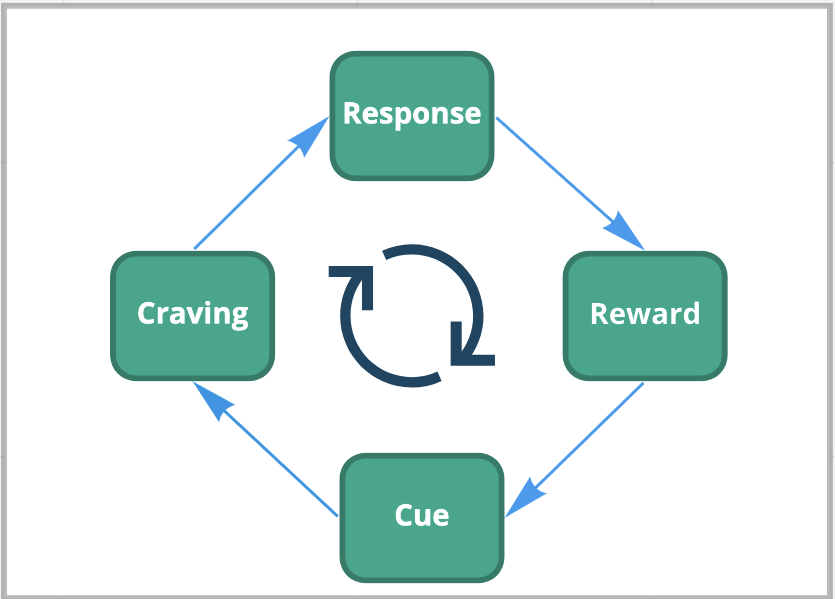‘Hooked’ - how users form habits?
This post is inspired by a great book written by Nir Eyal - ‘Hooked: How to Build Habit-Forming Products’. Although this subject gets a lot more attention in specific B2C products, its basic principles are still relevant to other sectors.
Why are habits relevant to software products?
As the old saying goes ‘we are all creatures of habits’… Habits can form without a person intending to acquire them. A lot of companies’ goal is to help customers form habits related to their products; see Facebook, Instagram, Spotify, and every app that is on your phone. Habit forming is deeply related to the core of people’s wants and desires. This is crucial to understand when creating software products for your target market so that you know how to get them ‘hooked’!
This also poses some ethical questions, as it can be associated with brainwashing or manipulating. This aspect is extremely important to recognise and will be touched on later in this blog.
How do we form habits?
Think about some habits that you acquired; you no longer think about brushing your teeth - just do it automatically. How about reaching out to check your phone - that happens more and more throughout the day and it gets harder to resist.

Cue is when something triggers your behaviour, it can be a piece of advertising, a conversation you had with someone, or peer pressure. Anything can be a cue for building a new habit, good or bad. Let’s think about the example of you receiving a message on your phone.
Craving is the desire to change your internal state. When your attention is directed at something, for example your phone, by a cue, then it is difficult to resist temptation - you keep thinking about checking it. You want to satisfy your curiosity and change your state to being calm and able to move on with your day.
Response. You react to your craving as it is too hard to dismiss it. You check your phone.
Reward. Your craving has been satisfied and your internal state has been changed. You are now calm as you know who messaged you and why. Your fear of worrying you might miss something is no longer there.
All of those four aspects of habit building when repeated form a habit loop. In the phone example, the cue - trigger of receiving a message becomes associated with the feeling of relief, excitement and calmness.
Old habits die hard.
It is very difficult to break our existing habits; it involves diverting from those already formed neural pathways. Think about the Qwerty keyboard!

The keys were arranged this way in the late eighteen hundreds, way before computers were invented, so that the most common letters are in hard to reach spots, to slow typists down and try to avoid keys jamming! Why are we still using it today? Out of habit. There is not enough incentive to change it.
People often get used to software or the old way they have been doing things and it is very difficult for them to change it. This is why new companies in an established space have a ten times harder task to win those customers over and convince them to switch!
The journey from Trigger to Reward.
There are two different types of triggers; internal or external. Internal trigger comes from a deep internal need, for example to be loved. External triggers are things like adverts; they focus our attention on our internal needs. This distinction is linked to Customer Motivation; do they seek a solution or do they find a problem?

There are also different types of rewards the users will be after. This classification comes from our basic human needs and desires, based on how we’ve evolved over thousands of years and is related to: Tribe (search for social rewards, connection), Hunt (material, information search), Self (autonomy, mastery, completion).
In order to establish/ initiate any behaviour the user needs:
- Sufficient motivation.
- Ability to perform action. This needs to be very easy to accomplish.
- Trigger must be present and be on hand.
- Reward. This must be associated with meeting the internal need; dopamine rush, feeling loved, feeling needed, and so on.
Which users’ needs are you meeting?
To create a new habit user is driven by:
- Gaining pleasure, hope, acceptance
- Avoiding pain
There needs to be a strong association between the product and Internal Trigger, as a result of a habit loop. This can be accomplished by doing the following:
- Establish persistent routine with the product
- Know users’ internal triggers; knowing customers and understanding how they are feeling. Identify the source of users’ pain and what they are looking for to relieve it.
- Users don’t often know what they are feeling and needing. If asked, they will often answer ‘What they would like to need?’, often giving a solution rather than talking about their feelings; e.g. they would say they want to exercise more but what they end up doing is play an online game or watch tv.
How to learn about users?
Use the 5 WHYs technique, usually the nature of the problem would become apparent only after asking ‘why’ multiple times, for example:
A: WHY do you want to check the message on your phone? B: To read the content. A: WHY? B: To see who sent it. A: WHY? B: To see if they need anything. A: WHY? B: To make sure I don’t let them down. A: WHY? B: I want to be loved and needed.
Suddenly being loved and needed is associated with the sound of a received message.
Are you building a vitamin or a painkiller?
Painkillers and vitamins are two different types of products. Painkiller is solving a defined problem, something that the user must have, like we go to the shop and buy goods to satisfy our hunger. Vitamins (nice to haves) don’t necessarily solve a problem but they help the users’ emotional needs; they think they are preventing something bad happening in the future and feel good about looking after themselves.
Habit forming technologies are both. In users’ eyes, initially it is a vitamin but then they start associating the product with a particular pain that they have, and see it as a solution.
To establish a new habit potential measure 2 Factors:
- Frequency (how often the behaviour occurs)
- Perceived utility (how much better/more useful customers find it vs if they use competitors)

The ethical dilemma of customers getting ‘hooked’ on new products.
Nir Eyal, in his book ‘Hooked’, presents the readers with the Manipulation Matrix. When building software products, we should ask ourselves two questions:
- Would I use this product myself?
- Would the product help improve the user’s life?
This can be answered on a scale of 1 to 10, and it gives some form of responsibility and accountability. Every company should have a set of core values they adhere to, where the main goal is not purely revenue driven. It is the company’s responsibility to promote their vision, mission and values across the organisation and make sure everyone understands them so that they can make meaningful decisions. Doing this correctly can prevent scandals like Volksvagen cheating the emission tests, where clearly the key drivers were financial gains or fears of not meeting targets and deadlines.
I would like to believe that using any form of manipulation or reaching goals in unethical ways in today’s world is very difficult to hide, and when it does come to surface it can have serious consequences to the company’s reputation. Even gambling companies introduced caps to money spent.
Checklist for maximising lifetime value.
Consider this checklist when you are trying to maximise your product’s lifetime value:
- What habits does your business model require?
- What problem do users want to solve?
- How do they solve this problem now and why does it need a new solution?
- How frequently would you expect the user to engage with your product?
- What user behaviour do you want to make into a habit?